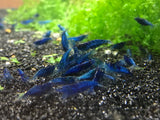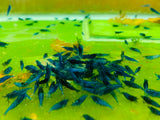
The Blue Dream Shrimp is a popular choice for freshwater shrimp hobbyists because of its stunning blue color as well as being relatively easy to care for and breed.
Blue Dream Shrimp make a striking and dynamic addition to a freshwater aquarium. These shrimp are very active as they scavenge the tank, cleaning up waste. They love to feed off of naturally occurring biofilm and algae, especially in a planted tank. For this reason, they can be quite low maintenance; in fact, they can even help keep your tank clean! Blue Dream Shrimp can withstand a pretty wide range of water parameters, and are not an aggressive species. This combined with their versatility makes them a good option as tank companions. Blue Dream Shrimp breed easily, making them a good choice for beginners to the freshwater shrimp hobby.
- Size: N. davidi are small, with females growing to a maximum size of 3–4 cm (1.2–1.6 inches) and males typically being slightly smaller.
- Temperament: They are peaceful scavengers that spend most of their time grazing on algae, biofilm, and decaying plant matter. In an aquarium, they help keep the tank clean.
-
Appearance: The wild-type coloration is a mottled greenish-brown. However, selective breeding has created numerous color morphs, including:
- Red: The most famous variety, often called Cherry, Sakura, or Fire Red shrimp.
- Yellow: Yellow Goldenback and Yellow Sakura shrimp.
- Blue: Blue Dream, Blue Velvet, and Blue Jelly shrimp.
- Green: Green Jade shrimp.
- Black/Brown: Black Rose and Chocolate shrimp.
- Patterned: Rili shrimp, which have translucent midsections with colored heads and tails.
- Sexual dimorphism: Females are larger and more vividly colored than males. They also develop a "saddle"—unfertilized eggs in their ovaries visible behind their head—and carry eggs, known as being "berried," under their tail.
- Tank setup: Neocaridina are ideal for a species-only tank of at least 5 gallons, though a 10-gallon or larger tank offers more stability. They prefer heavily planted environments with features like driftwood, rocks, and leaf litter for grazing and hiding.
-
Water parameters: This species is tolerant of a wide range of conditions, but stability is key. They thrive in:
- Temperature: 68–78°F (20–25°C)
- pH: 6.5–8.0
- Hardness (GH): 6–8
- Ammonia/Nitrite: Always 0 ppm
- Nitrate: Below 20 ppm
- Diet: As omnivorous scavengers, their diet can be supplemented with high-quality shrimp pellets, algae wafers, blanched vegetables, and powdered foods for juveniles.
- Breeding: They are prolific and easy to breed in captivity. Females carry 20–40 eggs for 2–3 weeks, after which the young hatch as miniature versions of the adults (direct development).
- Caution: These shrimp are highly sensitive to copper, which is present in some plant fertilizers and medications. They also require a fully cycled and stable tank, as they are susceptible to rapid changes in water chemistry.











